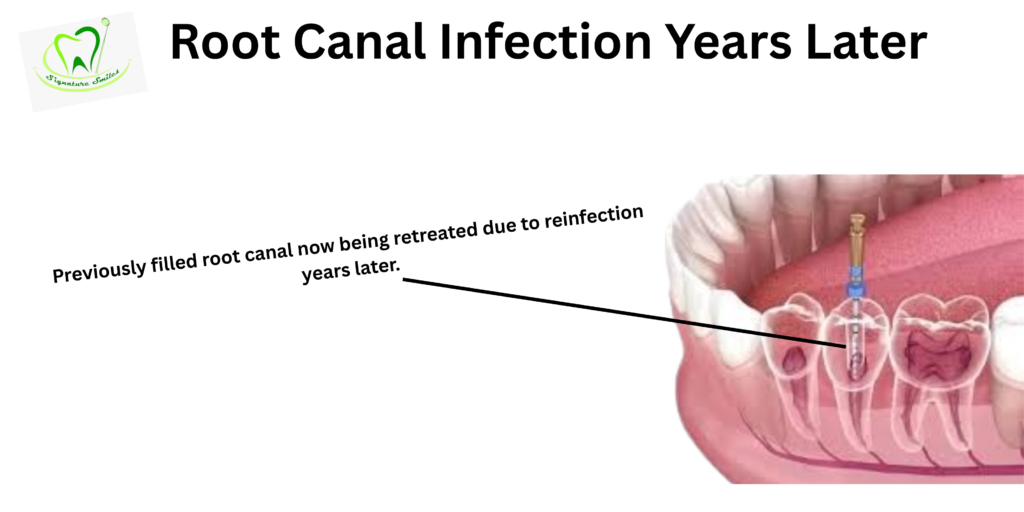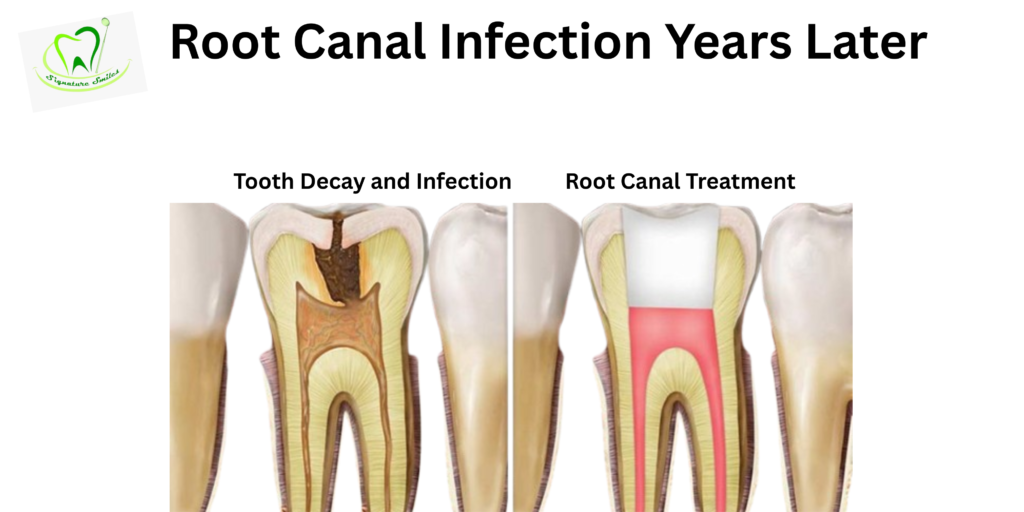Learn the reasons behind a root canal infection years later, how dentists diagnose it, and the best treatment options available.
Introduction: Understanding Root Canal Infections and Their Long-Term Impact
When a tooth is badly decaying or diseased, root canal therapy is frequently considered the last option. But what happens when problems arise years later? Surprisingly, root canal infection years later is a more common concern than many patients expect. Even after successful treatment, bacteria can linger or re-enter the tooth, leading to an infection that threatens dental health and overall well-being.
This article discusses the signs, symptoms, causes, and treatments for root canal infections that occur long after the initial procedure, along with actionable prevention tips to help maintain oral health.

The Anatomy of Root Canal Procedures: A Brief Overview
A root canal removes irritated or infected pulp from the inside of the tooth. Connective tissue, nerves, and blood vessels are all found in the tooth’s pulp. When this tissue becomes infected, it must be cleaned, disinfected, and sealed using materials like gutta-percha.
While this procedure is highly successful, root canals and infections can sometimes reappear even years later due to hidden bacteria, failed fillings, or other complications.
Signs and Symptoms of Root Canal Infection Years Later
It is essential to identify the signs of a root canal infection years later to take prompt action. If an infection is left untreated, it may spread to the sinuses, jawbone, or even the blood.
Common Signs of Root Canal Infection:
- Persistent or recurring tooth pain
- A dull ache or a sudden, shooting agony are common descriptions. Swelling in the gums or face
- (especially near the previously treated tooth)
- Tooth sensitivity to hot or cold
- (lingering discomfort after the trigger is gone)
- Pimple or bump on the gums
- (An indication of an abscess in the gums or tooth roots ) Darkening or discoloration of the tooth
- (indicating dying or infected tooth pulp)
- Bad breath or bad taste in the mouth
- (from pus drainage or infected root canal bacteria)
If you’ve noticed these root canal symptoms of infection, it’s essential to see a dentist. Ignoring the signs of tooth infection can lead to more serious consequences, including jawbone damage or even sepsis.
The Factors Leading to the Recurrence of Root Canal Infections
Several issues can cause a root canal to become infected years after treatment:
1. Incomplete Cleaning During Initial Procedure
If infected pulp or bacteria were not fully removed, they could multiply over time.
2. Leaky or Broken Crown
A fractured tooth or a poorly fitted dental crown may let bacteria return to the root-canaled tooth.
3. Tooth Fracture
A fracture can expose the sealed area of the tooth, letting bacteria in.
4. Root Canal Issues Years Later Due to Hidden Canals
Some teeth have tiny, hard-to-locate canals that may be missed during treatment.
5. Weakened Immune System or Other Health Issues
Conditions like diabetes or autoimmune diseases can reduce your body’s ability to fight infections, making you more prone to root canal infections and gum or tooth root canal abscesses.

Treatment Options for Chronic Root Canal Infections
A root canal infection that appears years later isn’t hopeless. Modern dentistry offers several effective treatments.
✅ Root Canal Retreatment
Your dentist will reopen the tooth, remove the old filling material, clean any new infected tissue, and reseal the canal.
✅ Apicoectomy (Root-End Surgery)
If retreatment isn’t possible, this minor surgical procedure involves removing the tip of the tooth’s root and sealing it to prevent further infection.
✅ Tooth Extraction and Replacement
If the tooth is too damaged, extraction might be the only option, followed by a dental implant, bridge, or partial denture.
✅ Antibiotics and Pain Management
Antibiotics may be prescribed for severe infections to control the spread of bacteria while other treatments are planned.
Preventive Measures to Avoid Future Infections after Root Canal Treatment
While root canal infection years later is frustrating, many cases can be prevented with good habits and professional care.
🦷 Practice Excellent Oral Hygiene
Use an antimicrobial mouthwash, floss, and brush twice a day.
🦷 Schedule Regular Dental Check-Ups
Routine exams allow your dentist to catch signs of infection early — even if you don’t feel pain.
🦷 Get Dental Restorations Checked
If you have crowns or fillings, check for cracks, leaks, or signs of decay.
🦷 Avoid Hard Foods and Bad Habits
Chewing ice or hard candies can crack the tooth, exposing it to bacteria.
🦷 Manage Underlying Health Issues
Keeping conditions like diabetes under control can reduce infection risk.
Frequently Asked Questions About Root Canal Infections
Q1: Can a root canal tooth get infected years later?
Yes. Infection can occur years after a root canal due to hidden bacteria, damaged dental work, or changes in oral health.
Q2: What are the signs of an infected root canal years later?
Pain, swelling, pus, bad breath, and sensitivity are common root canal symptoms of infection.
Q3: Can a dead tooth kill you?
If an infection from a dead tooth spreads into the bloodstream (sepsis), it can become life-threatening. Early treatment prevents this risk.
Q4: What are the signs that I need a root canal?
Persistent toothache, sensitivity, swelling, and tooth darkening are signs that you might need root canal treatment.
Q5: What happens if my root canal gets infected?
If untreated, it can lead to abscesses, gum disease, bone infection, and even tooth loss or the loss of neighbouring teeth.
Importance of Regular Dental Check-Ups for Long-Term Oral Health
Root canal treatment is designed to save a tooth and eliminate infection, but complications can still arise years later. Recognizing the signs of tooth infection and understanding the risks of an infected root canal years later empowers you to act quickly and seek treatment.
Ignoring a tooth root infection or dismissing tooth canal pain can lead to serious health consequences, including sepsis, tooth loss, or jawbone deterioration. A trusted dental professional can help detect issues early and suggest appropriate treatments like retreatment, apicoectomy, or tooth extraction.
🦷 Conclusion: Your Oral Health Deserves Attention!
If you’ve experienced tooth sensitivity, pain, or swelling in a tooth with a root canal, don’t wait for the discomfort to worsen. Infection years after the root canal is treatable, especially when addressed early.